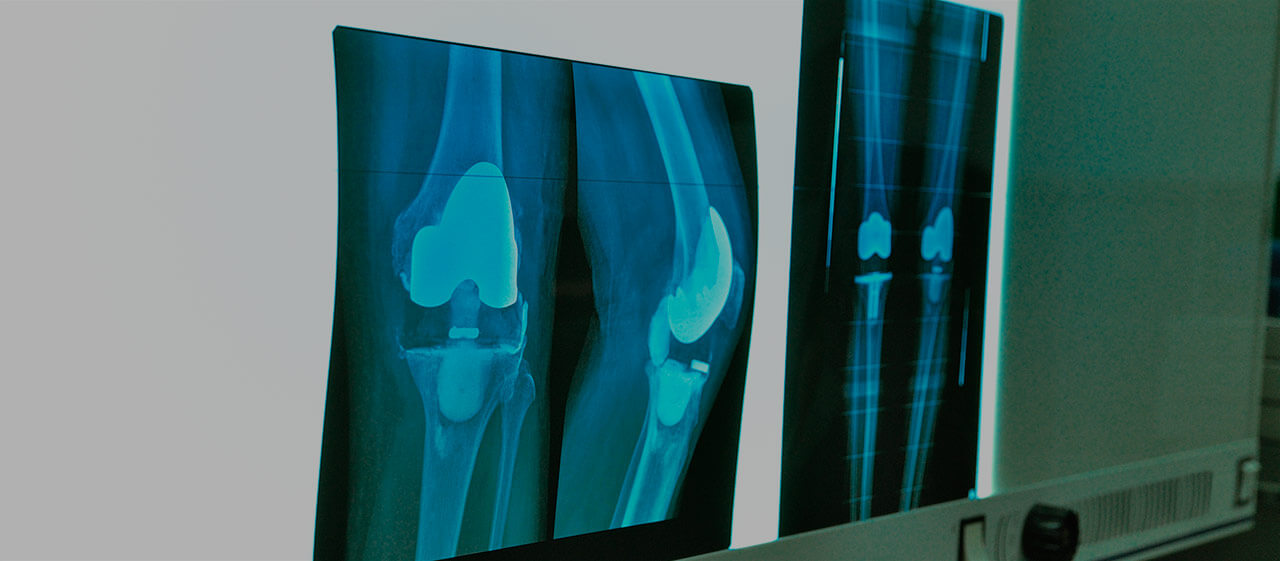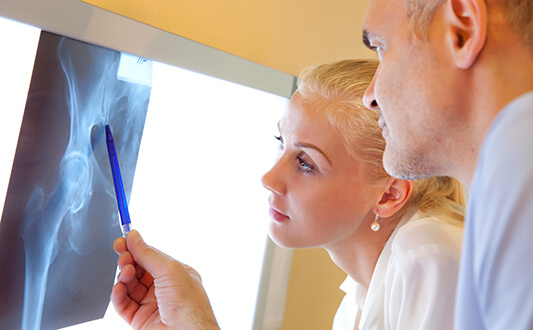If you need information about innovative treatments for sports injuries of joints, you can find it here
The specialized Orthopedic Centers and specialized departments of large University Hospitals in Germany offer foreign patients all types of classical joint replacement surgery according to international protocols and uniquely designed techniques by German specialists.
The surgeons' experience in sparing minimally invasive interventions, modern technical basis (high-resolution CT and MRI, 3D planning of operations, endoscopic equipment), high-quality prostheses, and individual rehabilitation schemes guarantee patients' high quality of life and lifespan of prostheses up to 15-25 years.
Content
- Indications for joint replacement surgery
- Knee replacement surgery
- Hip replacement surgery
- Shoulder replacement surgery
- Orthopedic rehabilitation and follow-up monitoring
- Prices for endoprosthetics and rehabilitation in leading German hospitals
- Organization of medical treatment in Germany for international patients
Indications for joint replacement surgery
In Germany, joint replacement surgery has the role of a second-line therapy, which is used only in the case of the ineffectiveness of conservative treatment methods and orthopedic rehabilitation. German surgeons set themselves three purposes:
- To maximally delay joint replacement surgery
- To preserve patient's bone tissue using sparing superficial joint replacement techniques and partial endoprostheses
- To select an individual prosthesis and the high quality of life after surgery
The list of indications for arthroplasty includes:
- Osteoarthrosis (stage III-IV disease with severe pain)
- Rheumatoid arthritis (stage III-IV disease with severe pain)
- Avascular necrosis of the femoral head or humerus, osteonecrosis of other locations
- Congenital hip dislocation or clinically significant hip dysplasia
- Serious traumatic injuries to the joints, including articular cartilage injuries
- Joint stiffness and joint dysfunction caused by other diseases
Knee replacement surgery
In most patients, knee replacement surgery is performed using one of the classical methods with proven effectiveness:
- Total or complete joint replacement surgery includes the replacement of the articular components of the femur and tibia, intra-articular cartilage, and, if necessary, replacement of the patella. Despite the high requirements for knee joint function, the prosthesis components in most cases are fixed using bone cement.
- Partial or unipolar replacement surgery most often involves replacing the medial (inner) part of the knee. As a rule, articular ligaments and cartilages are not affected. Due to the minor scope of the operation and the relatively small size of the prosthesis, the intervention can be performed endoscopically.
- Patella replacement surgery (patellofemoral arthroplasty) involves the replacement of the medial patella in its isolated lesion. Patellofemoral arthroplasty is indicated in the absence of signs of arthritis or other pathological processes in other joint components.
In addition to classical joint replacement surgery techniques, the German clinics offer a less invasive intervention, namely tibial osteotomy. This technique is used in unilateral knee lesions. The surgeon remodels the tibia in order to redistribute the load on the joint. As a result, the affected part of the knee is mainly in the state of available rest.
Hip replacement surgery
Hip replacement surgery is the primary type of treatment for hip fractures, particularly in elderly patients. At the same time, this type of arthroplasty can often be required for young, physically active patients. In order to maximally meet the needs of patients of all age groups, the German surgeons specializing in orthopedics use two fundamentally different treatment methods. These include:
- Total or complete joint replacement surgery involves the replacement of the femoral head and neck, the inner surface of the acetabulum, and articular cartilage. A plastic spacer is placed between the components of the prosthesis, which protects the joint components from premature wear and, if necessary, is a source of antibiotics. The last aspect is essential for patients with compromised immune systems (for example, with immunodeficiency or diabetes mellitus) and osteomyelitis in medical history.
- Sparing superficial hip replacement surgery, according to Prof. McMinn's technique, is the best choice for young patients and patients with a high level of physical activity. In this case, the surgeon preserves the femoral head and neck, replacing only the damaged articular surface. This is important for patients who potentially require revision intervention since the service life of even the highest quality prostheses does not exceed 20-25 years. According to McMinn's technique, Arthroplasty creates favorable conditions for subsequent implantation of the total or new superficial endoprosthesis.
Shoulder replacement surgery
In the case of the shoulder joint, the replacement surgery in Germany has two anatomically different types of arthroplasty. These include:
- Physiological replacement surgery can be total or partial, depending on the degree of damage to the components of the shoulder joint. In physiological arthroplasty, the shape of the prosthesis completely imitates the shape of a normal shoulder joint. This type of operation is used in patients with normally functioning muscles of the rotational cuff. Hemiarthroplasty involves humeral head replacement, whereas total replacement surgery consists of replacing the humeral head and glenoid cavity.
- In the case of reverse replacement surgery, the supporting surfaces of the joint change places – the spherical head are placed on the scapula, while the humeral cup is placed on the humerus. Such non-standard prosthesis is suitable for patients with injured muscles of the rotational cuff who cannot use classical prostheses. The reversible design allows patients to make movements in the joint solely using the deltoid muscle.
Orthopedic rehabilitation and follow-up monitoring
Regardless of the main disease and type of arthroplasty, the treatment in Germany always ends with orthopedic rehabilitation. The rehabilitation program begins at the hospital on the next day after the arthroplasty. All exercises are performed under the complete guidance of a qualified instructor.
After discharge from the hospital, the patient continues to perform the recommended set of exercises at home or visits a specialized center for physiotherapy and exercises on simulators, which include the following activities:
- Exercises to strengthen the muscles of the body and the operated limb
- Physiological load on the operated limb with intensity modulation
- Passive working out of joints or CPM therapy
- High-intensity laser therapy or HIL therapy
- Extracorporeal shockwave therapy
- Massage
- Electrical stimulation
- If necessary, psychotherapy, individually or in a group
Prices for endoprosthetics and rehabilitation in leading German hospitals
The cost of medical interventions in German hospitals is regulated by the DRG system, which stands for Diagnosis-related Groups. DRG system takes into account:
- Patient's age
- Diagnosis and severity of the pathology
- Type of treatment
- Type of accommodation for inpatient treatment (single or double room)
The total cost of treatment also depends on the doctor's fee (for example, treatment by the Head physician of the department will be more expensive than treatment by an assistant Physician), the type of the hospital (university, academic, etc.), the duration of inpatient treatment, and other factors.
The average cost of large joints replacement and postoperative rehabilitation is as follows:
- Hip replacement – 27,540 €
- Hip replacement with rehabilitation – 36,350 €
- Bilateral hip replacement – 34,620 €
- Bilateral hip replacement with rehabilitation – 45,150 €
- Knee replacement – 28,040 €
- Knee replacement with rehabilitation – 36,890 €
- Bilateral knee replacement – 41,140 €
- Bilateral knee replacement with rehabilitation – 48,420 €
- Orthopedic rehabilitation – 461 € per day
Depending on the clinical situation, you can undergo an entire course of treatment in Germany, including surgery and rehabilitation, or continue the recovery in your native country under the remote supervision of a German specialist.
Organization of medical treatment in Germany for international patients
The international patients are treated in Germany with the assistance of the medical tourism operator – the Booking Health company. The mission of Booking Health is to make qualified, high-tech medical care available for patients worldwide. The feedback of many patients confirm our specialists' high level of competence.
The employees of Booking Health will help you with such important issues:
- Selection of the right hospital based on the annual qualification profile
- Establishment of direct communication with your physician
- Preparation of a medical program in advance, without repeating previous examinations
- Provision of favorable costs for joint replacement surgery, without overpricing and additional coefficients for foreign patients (saving up to 50%)
- Booking the appointment with a doctor on the necessary date
- Monitoring of the medical program at all its stages
- Assistance in buying and forwarding medicines
- Communication with the hospital after treatment completion
- Control of invoices and return of unspent funds
- Organization of additional examinations
- Top-class service: booking hotels and plane tickets, transfer organization
Choose treatment abroad and you will for sure get the best results!
See the interview for more information:
JOINT RESTORATION AND ARTHROPLASTY IN GERMANY – interview with Prof. Dr. med. Oliver Hauschild
Authors:
The article was edited by medical experts, board certified doctors Dr. Vadim Zhiliuk, Dr. Nadezhda Ivanisova. For the treatment of the conditions referred to in the article, you must consult a doctor; the information in the article is not intended for self-medication!
Sources:
Read:
Why Booking Health - questions and answers
How to make right decision when choosing the clinic and specialist
7 reasons to trust to the rating of clinics on the Booking Health portal
Don't know where to start?
Contact Booking Health







